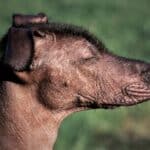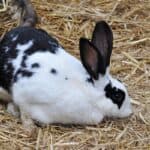When we think of a bunny, that little furry animal with long ears and a pretty face always comes to mind. However, there is a breed of hairless rabbit that will attract a lot of attention. It is a species known by its English name, hairless rabbit.
If you are curious to know the origin and characteristics of these very special rabbits, we will tell you everything here.
Origins of the hairless rabbit
The place of origin of the hairless rabbit is Australia and it arises from a mutation. This mutation is developed by a mating between rabbits of the same family, because they are in captivity too long.
Obviously, these rabbits are not “natural”. That is, they have not been developed as a result of a natural mutation as it corresponds in nature. All animal species develop and adapt to new environments and evolve over the years, leading to better survival capabilities. However, given the very important function that hair has in a rabbit, it is almost impossible for nature to have decided that the rabbit would adapt to a dangerous environment without hair.
The origin of the hairless rabbit or hairless rabbit dates back to a given mutation between inbreeding or mating between specimens that has a close family relationship. That is, among animals that are in captivity for a long time. This curious species is more frequent in crosses of Rex rabbits. It occurs because the parents have a recessive gene that appears as a small bald spot on the head. When two rabbits with this small baldness that, during their growth is covered with hair again, mate, the fruit of this cross is a hairless rabbit.
These rabbits are quite delicate .
How does the crossbreed of the hairless rabbit originate?
For the type of recessive gene that gives rise to the hairless rabbit, there are several alleles and some combinations. We collect them here:
FF: for normal rabbit
Ff: it is the specimen that has a small area of bald spots on its body. The most normal thing is that that bald spot is on the head. Without animals strong enough to survive on their own. As it develops, all the bald spots it had are recovered from hair. This is the way in which the rabbit is recognized as having the recessive gene that will result in the offspring having no hair.
ff: This is the rabbit that has no hair on most of its body. They are delicate and do not usually have a very long life.
If these animals manage to interbreed with other furry rabbits, the offspring will be somewhat stronger and the genes will take shape. On the contrary, if two hairless rabbits are crossed, the offspring are doomed to die. This is also the case with sphynx hairless cats, which were very weak until they were interbred with hairless cat breeds.
To strengthen the offspring of these rabbits, open crosses must be made with other breeds that have greater genetic strength. This is how, after generations of rabbits, these animals can be endowed with powerful genetics that are capable of resisting in the environments they find themselves. It is a very slow process since the recessive gene causes unexpected mutations. However, the basis of the study is to carry out a good breeding program so that the genes that are acquired in descendant generations are consolidated until a new breed of rabbits is created.
This breed has the special characteristic of not having hair and still being able to adapt to new environments and scenarios because it has other enhanced genes that allow it to survive.
Being such delicate animals, it is not very common to have a hairless rabbit as a pet.
Health and reproduction of hairless rabbits
The hair in rabbits is essential for their protection and health. It serves as a defense against injuries, against extreme temperatures and as camouflage in some cases. That is why hairless rabbits are excessively delicate and do not survive for long if they are not cared for very carefully. They involve more money than other types of rabbits.
There are still many studies to be done to learn more about these little ones. These investigations will take time, but surely, after several generations being born in this way, hairless rabbits will emerge that will be able to adapt, since their genetics will have been strengthened.






